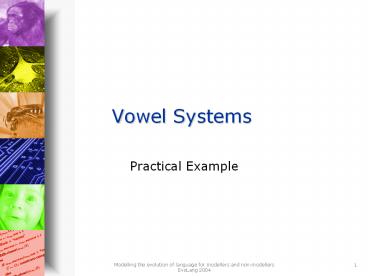Modelling the evolution of language for modellers and non-modellers - PowerPoint PPT Presentation
Title:
Modelling the evolution of language for modellers and non-modellers
Description:
Vowel Systems Practical Example Why speech? Cross-linguistic data available On universals On acquisition On language change This data is relatively uncontroversial As ... – PowerPoint PPT presentation
Number of Views:169
Avg rating:3.0/5.0
Title: Modelling the evolution of language for modellers and non-modellers
1
Vowel Systems
- Practical Example
2
Why speech?
- Cross-linguistic data available
- On universals
- On acquisition
- On language change
- This data is relatively uncontroversial
- As opposed to e.g. syntax
3
Speech is easy to model
- It is a physical signal
- We can use existing techniques
- Speech synthesis techniques
- Speech processing techniques
- Even neural processing models
- Results are directly comparable to the real thing
4
The aim of the study
- Explain universals of vowel systems
- Why are do certain (combinations of) vowels occur
more often than others(acoustic distinctiveness) - How does the optimisation take place?
- Hypothesis
- Self-organisation in a population under
constraints of production, perception, learning
causes optimal systems to emerge - Model
- Agent-based model
- Imitation games
5
Computational considerations
- Simplification 1
- Agents communicate formants, not complete signals
- Greatly reduces the number of computations
- Perception, production already in terms of
formants - Simplification 2
- No meaning (problem phonemes are defined in
terms of meaning) - Imitation is used instead of distinguishing
meaning
6
Architecture
- For vowels
- Realistic productionarticulatory
synthesiser(Maeda, Valleé) - Realistic perceptionFormant weighting(Mantakas,
Schwarz, Boë) - Learning modelPrototype based associative memory
7
The interactions
- Imitation with categorical perception
- Humans hear speech signals as the nearest phoneme
in their language (?) - Correctness of imitation depends not only on the
signals used, but also on the agents repertoires
Initiator
Imitator
8
Imitation failure
Initiator
Imitator
9
Distributed probabilistic optimization
- Pick an agent from the population
- Pick a signal from this agent
- Modify the signal randomly
- Play imitation games with all other agents in the
population - If success of modification is higher than success
of original vowel, keep the change, otherwise
revert. - Disadvantage
- Number of signals per agent is fixed beforehand
10
Reactions to imitation game
F2
Shift Closer
F1
Throw away Vowel
Add Vowel
Merge
11
Measures
- Imitative success
- Energy of vowel systems (Liljencrants Lindblom)
- Size
- Preservation
- Success of imitation between agents from
populations a number of generations apart - Only in systems with changing populations
- Realism































